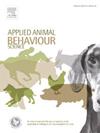不同社会动机水平的选择对日本鹌鹑行为曲目和同步性的影响
IF 2
2区 农林科学
Q1 AGRICULTURE, DAIRY & ANIMAL SCIENCE
引用次数: 0
摘要
行为同步是指个体在接近的情况下同时执行相同的行为。它被广泛认为是促进群体内社会凝聚力、协调和合作的关键机制,提供了实质性的适应性利益。然而,由于群体内的个体往往在社会倾向上表现出个体间的差异,这些差异可能会影响群体组织和同步发生的程度。本研究通过比较10个高社会动机组(S+)和10个低社会动机组(S-),研究了日本鹌鹑(Coturnix japonica)社会动机的遗传选择(即个体寻求接触、接近和保持接近群体的内在动力)如何影响它们的行为库和行为同步。为此,三人组被放置在一个充满木屑的竞技场中连续24小时,并提供随意的饲料和水。在4个1小时的时间窗口(1小时8:30-9:30 am, 2小时11:00-12:00 am, 3小时1:30-2:30 pm和4小时4:00-5:00 pm)记录和分析鸟类的行为。结果表明,S-鹌鹑表现出更多的运动行为,而S+ 鹌鹑表现出更多的不活动行为,特别是“坐放松”行为。S+ 个体的总同步持续时间也比S-个体长。具体来说,与S-鹌鹑相比,S+ 鹌鹑表现出更多同步的“放松坐姿”行为,在这种状态下花费更多的时间,并且在“放松坐姿”期间保持同步的时间更长。S+ 组总体Kappa系数显著高于对照组,“坐轻松”行为Kappa系数显著高于对照组,两者均与0有显著差异,表明S+ 组存在与协调群体动态相一致的行为同步的结构化模式。值得注意的是,在“坐下放松”行为的同步回合中,鸟类减少了个体间的距离,表明在此活动中主动倾向于保持更近的距离。总的来说,这些发现表明,具有较高社会动机的个体更有可能参与同步行为,特别是在休息行为中,这可能会促进亲密关系并加强社会联系。这种同步可能会促进社会凝聚力,并导致更和谐和稳定的群体动态。进一步的研究将有必要更好地阐明这些影响,并证实这些不同的假设。本研究强调了社会动机的个体差异在塑造集体行为中的关键作用。这些见解增强了我们对动物社会动态的理解,并有助于制定更有效的畜牧业管理策略。本文章由计算机程序翻译,如有差异,请以英文原文为准。
Effects of selection for divergent levels of social motivation on behavioral repertoire and synchronization in Japanese quail (Coturnix japonica)
Behavioral synchronization occurs when individuals perform the same behavior simultaneously and in close proximity. It is widely recognized as a key mechanism that fosters social cohesion, coordination, and cooperation within groups, providing substantial adaptive benefits. However, since individuals within a group often exhibit inter-individual differences in social tendencies, these variations may influence group organization and the extent to which synchronization occurs. Here, we investigated how genetic selection for social motivation (i.e., an individual’s internal drive to seek contact, approach and remain close to a group of conspecifics) in Japanese quail (Coturnix japonica) impacts their behavioral repertoire and their behavioral synchronization, by comparing 10 trios (groups of three) constituted of individuals selected for high social motivation (S+) and 10 trios constituted of individuals selected for low social motivation (S-). For this purpose, trios were placed for 24 consecutive hours in an arena filled with wood shavings and providing ad libitum access to feed and water. Birds’ behaviors were recorded and analyzed during four one-hour time windows (hour 1: 8:30–9:30 am, hour 2: 11:00–12:00 am, hour 3: 1:30–2:30 pm and hour 4: 4:00–5:00 pm). Results revealed that S- quail exhibited more locomotion behaviors, while S+ quail displayed more inactivity behaviors and particularly "sit relaxed" behaviors. Also, S+ individuals had a longer total synchronization duration than S- individuals. Specifically, S+ quail performed more synchronized "sit relaxed" behaviors, spent more time in this state and remained synchronized longer during a "sit relaxed" bout compared to S- quail. The S+ group also exhibited a significantly higher overall Kappa coefficient, as well as a higher Kappa coefficient for the behavior "Sit relaxed", both of which significantly differed from 0, indicating a structured pattern of behavioral synchronization consistent with coordinated group dynamics. Notably, during synchronization bouts of the behavior "Sit relaxed", birds reduced inter-individual distances, indicating an active preference for staying closer together during this activity. Overall, these findings suggest that individuals with higher social motivation are more likely to engage in synchronized behaviors, particularly during resting behaviors, which may promote close proximity and strengthen social bonds. Such synchronization may foster social cohesion and lead to more harmonious and stable group dynamics. Further studies will be necessary to better elucidate these effects and confirm these different hypotheses. This research highlights the critical role of individual differences in social motivation in shaping collective behavior. These insights enhance our understanding of animal social dynamics and could contribute to more effective management strategies in animal husbandry.
求助全文
通过发布文献求助,成功后即可免费获取论文全文。
去求助
来源期刊

Applied Animal Behaviour Science
农林科学-行为科学
CiteScore
4.40
自引率
21.70%
发文量
191
审稿时长
18.1 weeks
期刊介绍:
This journal publishes relevant information on the behaviour of domesticated and utilized animals.
Topics covered include:
-Behaviour of farm, zoo and laboratory animals in relation to animal management and welfare
-Behaviour of companion animals in relation to behavioural problems, for example, in relation to the training of dogs for different purposes, in relation to behavioural problems
-Studies of the behaviour of wild animals when these studies are relevant from an applied perspective, for example in relation to wildlife management, pest management or nature conservation
-Methodological studies within relevant fields
The principal subjects are farm, companion and laboratory animals, including, of course, poultry. The journal also deals with the following animal subjects:
-Those involved in any farming system, e.g. deer, rabbits and fur-bearing animals
-Those in ANY form of confinement, e.g. zoos, safari parks and other forms of display
-Feral animals, and any animal species which impinge on farming operations, e.g. as causes of loss or damage
-Species used for hunting, recreation etc. may also be considered as acceptable subjects in some instances
-Laboratory animals, if the material relates to their behavioural requirements
 求助内容:
求助内容: 应助结果提醒方式:
应助结果提醒方式:


